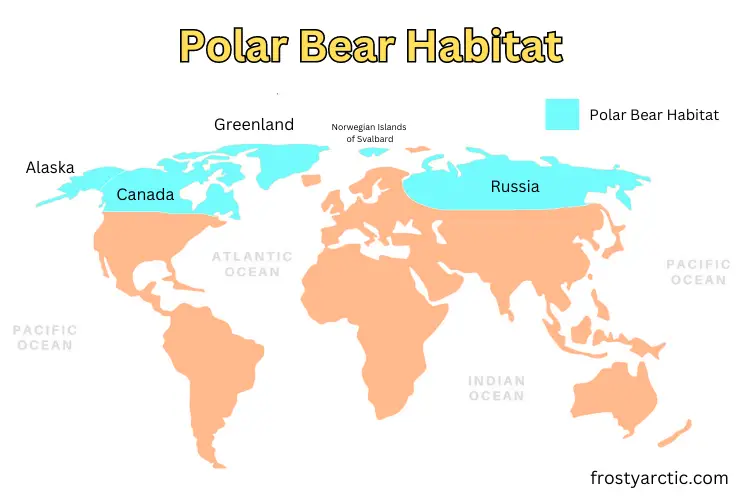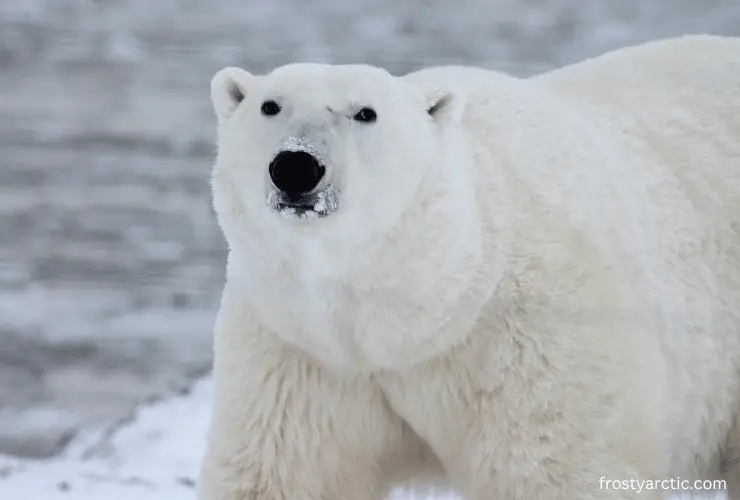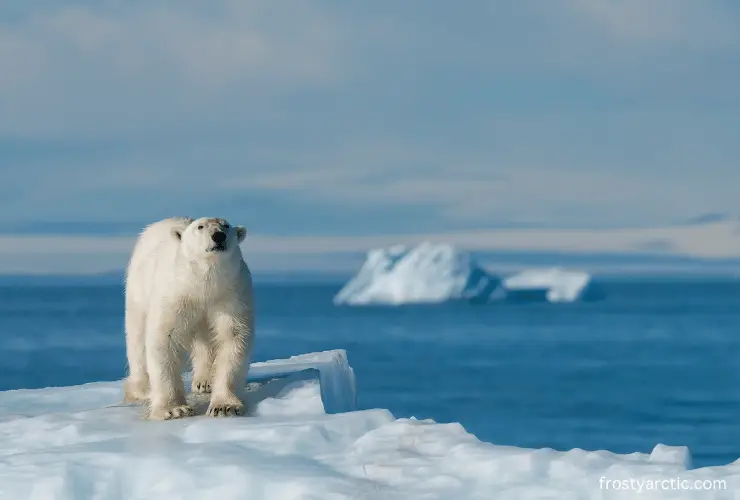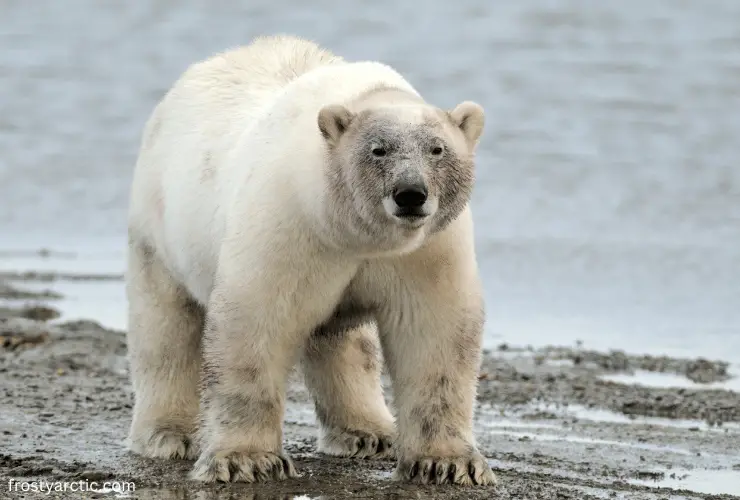The polar bear’s habitat stretches across the Arctic Circle and Newfoundland. They inhabit Alaska, Canada, Russia, Greenland, and Norway (Svalbard). All 19 populations of polar bears live in the Arctic Circle instead of Antarctica, despite the icy-cold environments on both poles.
Polar bears heavily depend on sea ice for survival. Let’s explore their ice-covered habitat in this article!
Where Can I Find Polar Bears? List of Regions Where Polar Bears Live
Polar bears inhabit the Arctic Circle, towards the North Pole. Their habitat extends from the Northern Arctic Circle to Newfoundland. Polar bears live in the following regions:

1. Alaska
Alaska is the only region in the United States that is home to polar bears. The climate in this state is ideal for the survival of polar bears.
According to the National Park Service, 4000 to 7000 polar bears inhabit Alaska.
2. Canada
In Canada, polar bears often gather at Churchill, Manitoba, the “polar bear capital of the world.”
In Autumn, polar bears migrate from inland areas in Canada to the shores of Hudson Bay, gathering at Churchill. Nearly 1,200 polar bears pass through this region during their migration. ~ Canada Polar Bears
They are often seen from October to November until the ice becomes strong enough on Hudson Bay, after which they leave the area to hunt seals on sea ice.
3. Russia
Polar bears cover an area of approximately 4 million square kilometers, including water, islands, and coasts in the Russian Arctic.
According to the Arctic WWF, their habitat in the Russian Arctic extends across the western Franz Josef Land to the Berin Strait in the east.
Four polar bear populations live in the Russian Arctic: Barents, Kara, Laptev, and Chukchi, which have been named after the seas that they live on.
Did you know? Nearly 3000 polar bears are part of the Chukchi Sea population. The bears mostly spend their time on the Bering, Chukchi, and East Siberian seas. ~ Polar Bear International Org
4. Greenland
A study funded by NASA found a rare population of polar bears living in Greenland, relying on glacial ice for survival instead of sea ice.
The previously unknown population, genetically different from the other subpopulations of polar bears, survive without much access to the sea. Instead, the Greenland species hunts from the freshwater ice from Greenland’s glaciers, pouring into the ocean.
This population is the most genetically distinct compared to other polar bears.
These animals have lived independently from other polar bear groups for hundreds of years, and their population has consistently stayed small during this period. ~ Co-author Beth Shapiro (professor and geneticist at the University of California)
5. Norwegian Islands of Svalbard
Svalbard is in the Arctic Ocean, between Norway and the North Pole. It is said that the polar bear population outnumbers the human population in Svalbard.
According to The Norway Guide, there are 3000 polar bears on the island, outnumbering the human population, estimated to be nearly 2600.
What Country is Known for Polar Bears?

Canada is known to be home to most of the world’s polar bears. Nearly 60% of the world’s polar bear population lives in Canada, in an area called Canada’s Inuit.
Polar bears are found in several regions across Canada, including Ontario, Quebec, Southern Hudson Bay, Manitoba, and most importantly, Churchill, Manitoba, also known as the world’s ‘Polar Bear Capital.’ ~ WWF CA
Most residents of Northern Canada often encounter polar bears, animals that play a significant role in the local culture of their region. However, melting sea ice pushes polar bears southward, forcing them to interact with humans more often, threatening both human and bear lives.
Do Polar Bears Live in the Ocean?
Yes, polar animals live on sea ice, which is why they are known as marine animals. The animals heavily rely on the sea ice of the Arctic Ocean for shelter and food.
Sea ice forms when the Arctic waters fall below a specific temperature. The bears travel, mate, and hunt their prey on sea ice.
Did you know? Polar bears are adept swimmers and can reach speeds of 6mph underwater. The animals can cover long distances using their pawas as paddles, swimming from one piece of ice to another. ~ WWF UK
Polar bears are the only mammals that are classified as marine animals.
According to Polar Bear International, they need a high-calorie diet to keep warm in the icy-cold climate of the Arctic. The animals eat seal blubber, one of the most calorie-rich foods in the world, which is only found in the ocean.
Although they are excellent swimmers, bears cannot outswim seals. Instead, they rely on sea ice to sneak up on their prey.
Where Do Polar Bears Nest?

Pregnant polar bears often nest on sea ice or snow drifts on land. They dig dens in the fall, waiting to give birth in the Winter.
These bears remain in their dens throughout the winter. Even after birthing their cubs, they stay in their holes, nursing and caring for their newborn cubs.
They then emerge from their dens in the spring, after which the female bear teaches them how to hunt. ~ National Geographic
WWF Arctic states that polar bears may even build dens in frozen peat banks in Canada.
FAQs
Why can’t polar bears live without ice?
Polar bears eat seals and can only hunt them on sea ice. So, the bears will not survive without sea ice.
Do polar bears live with penguins?
No, polar bears do not live with penguins. Polar bears live near the Arctic Circle, while penguins live at the North Pole.
Do polar bears live in Antarctica?
No, polar bears do not live in Antarctica. Their habitat extends from the Arctic Circle to Newfoundland.
Conclusion
Polar bears cannot survive without sea ice, except for the unique population of bears in Greenland. The rising temperatures are causing the sea ice to melt rapidly, threatening their survival.
Although several organizations are initiating programs to aid polar bears, conservation efforts must pick up speed to save polar bears around the world.
The Greenland population survives on glacial ice instead of sea ice. Scientists can study these genetically distinct bears to gain valuable insights into polar bear survival without sea ice.



3 thoughts on “Where do Polar Bears Live?”